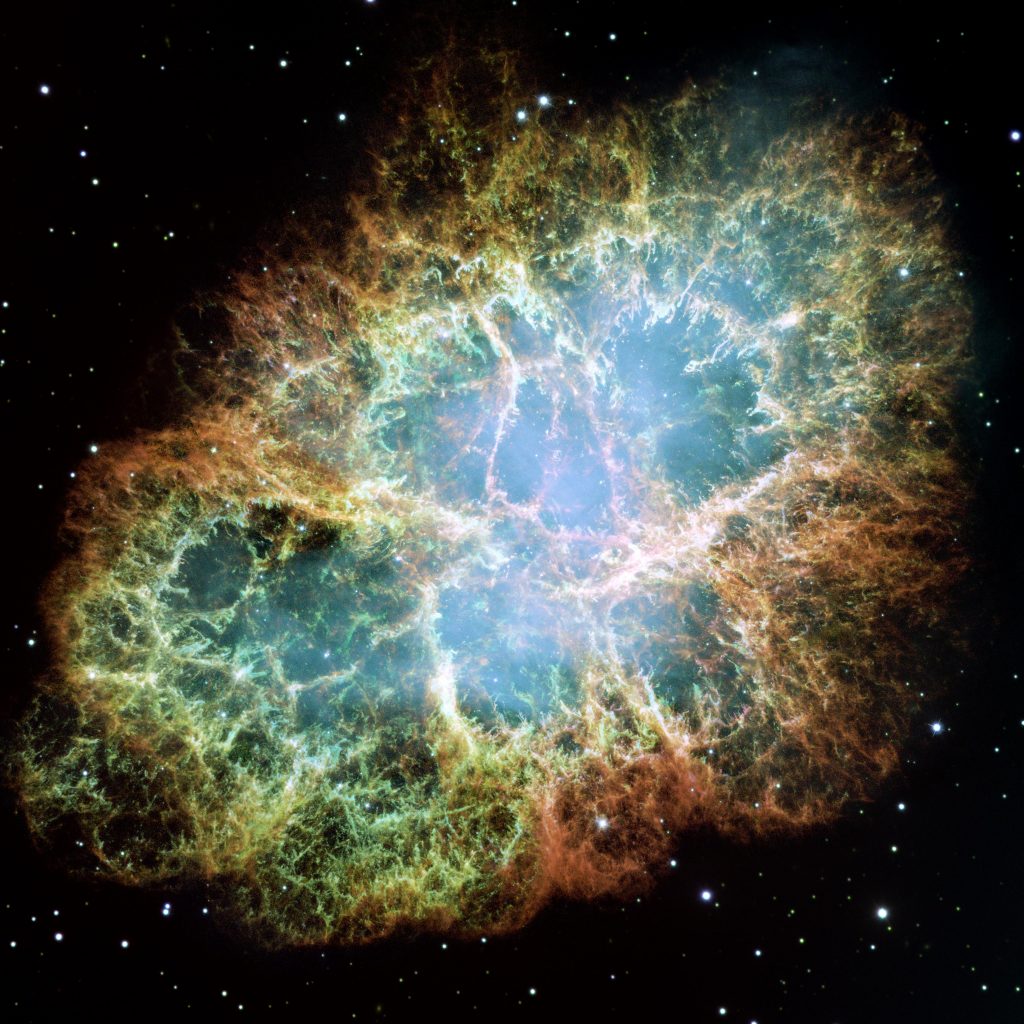The Strange Pulsar at the Center of the Crab Nebula
By Evan Gough
Thanks to the Hubble Space Telescope, we all have a vivid image of the Crab Nebula emblazoned in our mind’s eyes. It’s the remnant of a supernova explosion Chinese astronomers recorded in 1056. However, the Crab Nebula is more than just a nebula; it’s also a pulsar.
The Crab Pulsar pulsates in an unusual ‘zebra’ pattern, and an astrophysicist at the University of Kansas thinks he’s figured out why.
When massive stars explode as supernovae, they leave behind remnants: either a stellar-mass black hole or a neutron star. SN 1054 left behind the latter. The neutron star is highly magnetized and spins rapidly, emitting beams of electromagnetic radiation from its poles. As it spins, the radiation is intermittently directed towards Earth, making it visible to us. In this case, it’s called a pulsar.
Pulsars are complex objects. They’re extremely dense and can pack up to three solar masses of material into a sphere as small as 30 km in diameter. Their magnetic fields are millions of times stronger than Earth’s, they can rotate hundreds of times per second, and their immense gravity warps space-time. And their cores are basically huge atomic nuclei.
One result of their complexity is their radio emissions, and this is especially true of the Crab Pulsar.
Pulsars are known for their main pulse (MP), but they also emit other pulses that are more difficult to detect. In 2007, radio astronomers Hankins and Eilek discovered a strange pattern in the Crab Pulsar’s high-frequency radio emissions. This is the only pulsar known to produce these patterns between the pulsar’s main pulse (MP) and its intermittent pulse (IP).
“The mean profile of this star is dominated by a main pulse (MP) and an interpulse (IP),” Eilek and Hankins wrote in their paper. However, there are two additional pulses called HFC1 and HFC2 that create the zebra pattern.

Nobody has succeeded in explaining this unusual pattern. However, new research published in Physical Review Letters may finally explain it. The author is Mikhail Medvedev, who specializes in Theoretical Astrophysics at the University of Kansas. His research is “Origin of Spectral Bands in the Crab Pulsar Radio Emission.”
Medvedev says that the Crab Pulsar’s plasma-filled magnetosphere acts as a diffraction screen to produce the zebra pattern. This can explain the band spacing, the high polarization, the constant position angle, and other characteristics of the emissions.

A typical pulsar emits radio emissions from its poles, as shown in the figure below. They sometimes emit two signals per rotation period, one radio and one high frequency. They appear in a different phase of the rotation, with the higher frequency emission produced outside the light cylinder, the region where linear speed approaches the speed of light.

But the Crab Pulsar is different.
“The Crab pulsar is, in contrast, very special. Its radio main pulse and interpulse are coincident in phase with high-energy emission, indicating the same emission region,” Medvedev explains.
Medvedev explains that the High-Frequency Interpulse (HFIP) produced by the diffraction effect creates the zebra pattern. “The spectral pattern of the high-frequency interpulse (HFIP), observed between about
?~5 and ?~30 GHz is remarkably different and represents a sequence of emission bands resembling the
“zebra” pattern,” he writes.

Medvedev’s proposed model has an additional benefit. He says it can be used to perform tomography on pulsars to uncover more details about their powerful magnetospheres.
“The model allows one to perform “tomography” of the pulsar magnetosphere,” he writes.
“We predict that this HFIP properties can also be observed in other pulsars if their radio and high energy emission are in phase. This would happen if the radio emission is produced in the outer magnetosphere as opposed to the “normal” emission from the polar region,” Medvedev explains.

Medvedev says his model can also explain the HFC1 and HFC2 in the Crab Pulsar’s emissions spectrum. They’re also artifacts of his proposed diffraction model. “We propose that these high-frequency components are the reflections off the magnetosphere of the same source producing the diffracted HFIP,” he explains.
“To conclude, we propose a model, which explains the peculiar spectral band structure (the zebra pattern) of the high-frequency interpulse of the Crab pulsar radio emission,” Medvedev writes.
The post The Strange Pulsar at the Center of the Crab Nebula appeared first on Universe Today.

November 20, 2024 at 02:09AM
via Universe Today read more...

Post a Comment